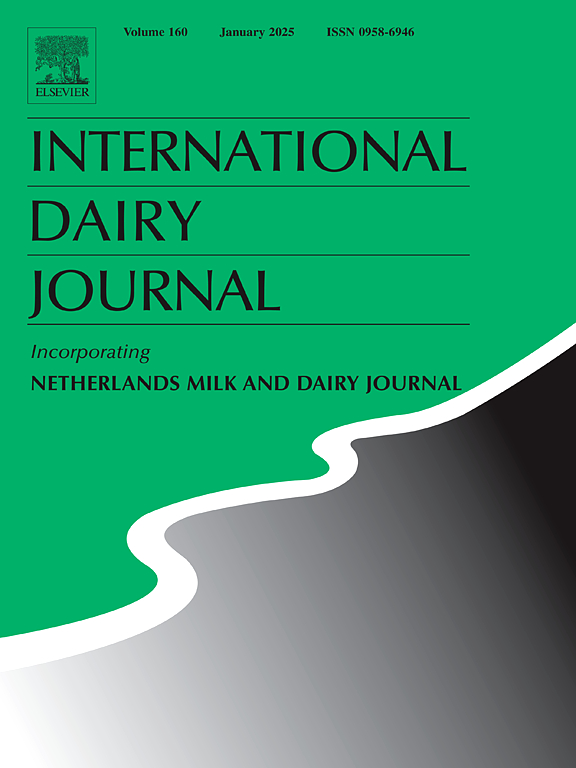Introduction of a novel graphene oxide-based nickel nanoflowers for ultrasound-assisted dispersive solid phase extraction of natamycin from dairy products
IF 3.1
3区 农林科学
Q2 FOOD SCIENCE & TECHNOLOGY
引用次数: 0
Abstract
This study presented facile ultrasound assisted dispersive solid-phase extraction coupled with high performance liquid chromatography-diode array detector for preconcentration and determination of trace levels of natamycin in dairy products. Highly efficient and selective graphene oxide-based nickel nanoflowers were synthesized and characterized with FE-SEM-EDX, FT-IR, TGA, and XRD techniques. The leading factors including pH, ionic strength, sample volume, the amount of sorbent, and desorption conditions were studied using matrix matched method. Good linearity of 1–750 μg kg−1 for milk, 1–500 μg kg−1 for yogurt and cheese were acquired. While 0.30, 0.27, and 0.30 μg kg−1 as LODs values and 1.00, 0.93, and 0.97 μg kg−1 as LOQs values were obtained for milk, cheese, and yogurt, respectively. The intra-day precision (n = 7) and the inter-day precision (5 days, n = 3) were achieved ≤4.1% and ≤3.0%, respectively, confirming the method's repeatability and reproducibility. High recoveries of 94.0–98.4% and also the satisfactory obtained results indicated high capability of the proposed method for separation and preconcentration of natamycin be applied in dairy products as complex matrixes.

介绍了一种新型的氧化石墨烯基镍纳米花,用于超声辅助分散固相萃取乳制品中的纳他霉素
本研究采用超声辅助分散固相萃取-高效液相色谱-二极管阵列检测器对乳制品中痕量纳他霉素进行预富集和测定。采用FE-SEM-EDX、FT-IR、TGA和XRD等技术合成了高效、选择性的氧化石墨烯基镍纳米花。采用基质匹配法研究了pH、离子强度、样品体积、吸附剂用量和脱附条件等主导因素。牛奶的线性范围为1 ~ 750 μg kg - 1,酸奶和奶酪的线性范围为1 ~ 500 μg kg - 1。牛奶、奶酪和酸奶的LODs分别为0.30、0.27和0.30 μ kg−1,loq分别为1.00、0.93和0.97 μ kg−1。日内精密度(n = 7)和日内精密度(5天,n = 3)分别达到≤4.1%和≤3.0%,证实了方法的重复性和再现性。回收率为94.0 ~ 98.4%,结果满意,表明该方法可作为复合基质用于乳制品中纳他霉素的分离富集。
本文章由计算机程序翻译,如有差异,请以英文原文为准。
求助全文
约1分钟内获得全文
求助全文
来源期刊

International Dairy Journal
工程技术-食品科技
CiteScore
6.50
自引率
9.70%
发文量
200
审稿时长
49 days
期刊介绍:
The International Dairy Journal publishes significant advancements in dairy science and technology in the form of research articles and critical reviews that are of relevance to the broader international dairy community. Within this scope, research on the science and technology of milk and dairy products and the nutritional and health aspects of dairy foods are included; the journal pays particular attention to applied research and its interface with the dairy industry.
The journal''s coverage includes the following, where directly applicable to dairy science and technology:
• Chemistry and physico-chemical properties of milk constituents
• Microbiology, food safety, enzymology, biotechnology
• Processing and engineering
• Emulsion science, food structure, and texture
• Raw material quality and effect on relevant products
• Flavour and off-flavour development
• Technological functionality and applications of dairy ingredients
• Sensory and consumer sciences
• Nutrition and substantiation of human health implications of milk components or dairy products
International Dairy Journal does not publish papers related to milk production, animal health and other aspects of on-farm milk production unless there is a clear relationship to dairy technology, human health or final product quality.
 求助内容:
求助内容: 应助结果提醒方式:
应助结果提醒方式:


